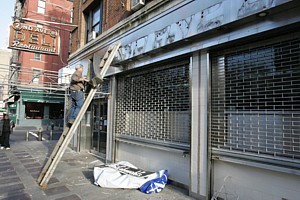

About once every two years, I hunker down for a lonely dinner at Jade Mountain on Second Avenue. I never invite anyone to go with me, partly because the food is not very good and I'm disinclined to foist it on anybody, and partly because no one would understand why I would want to eat as this seemingly run-down joint, and I'd have to spend the entire meal explaining myself.
Certainly, the few patrons I meet inside on my occasional visits can't fathom why I'm there. All ancient and gone-to-seed, they stare at me in wonder. They haven't seen me before, they know, and no one they haven't seen before patronizes Jade Mountain. Only old-time, low-income, down-on-their-luck, set-in-their-ways, died-in-the-wool Villagers like them.
I trot down the few steps from the sidewalk and pass the pay phone (a pay phone!) to the glass door on the right and enter. I never worry about finding a seat. Jade Mountain is virtually empty most of the time. I usually occupy an entire booth, my back to the big fishtank near the front and the glass case beneath the cash register which displays, I think, cigars. The decor is tan and brown. The ceiling is lowered and false. And there's a solitary booth near the street window, separate from the rest of the room. I've never seen anyone so sad that they're chosen to sit there.
The menu is a classic. It should be in the Smithsonian. "This is how Americans ate Chinese food from the 1920s through the 1970s," the museum wall text would read. The whole "Column A" and "Column B" bit and quasi-Sino entrees that no self-respecting Manhattan Chinese restaurant—or even the hole-in-the-wall take-out joints—would serve today. Chop Suey. Pepper Steak. Moo Goo Gai Pan. Dishes that countless Borscht Belt comedians based their weary old Chinese restaurant routines on. At the bottom of the front of the menu is the legend: "We are the oldest established restaurant since 1931 on 2nd Avenue serving famous Oriental food." In the inside pages, they recommend you leave your meal to the chef. (Chef!)
As I said, the food is not great. But it can be servicably tasty and is certainly free of pretense. As one travel guide put it, "Jade Mountain is not a good restaurant. But it is a very good bad restaurant." And some dishes stand out as singular. The fried dumplings are not the usual gooey globs found in the take-out places. They are attenuated and crispy. Certainly, they were frozen and tossed in a deep frier. But they somehow came out toothsome. And there is a specialty called Butterfly Shrimp, which I will let them describe: "fresh jumbo shrimp, split open, dipped in egg & flour batter and sauteed in oil, each luscious piece enfolded in bacon & onions and a special sauce." It is really bad for you and really quite remarkable. Worth a try. There are probably other gems hidden in the menu, but it's hard to find them among canned mushrooms and water chestnuts.
Another thing: no music plays. This is an extreme rarity in New York, where loud music invariably chases out the quiet thoughts and tests the lungs of diners.
I don't know much about the history of the place, but it appears to have been founded by a Chinese anarchist named Eddie and a few other fellow waiters who had once worked together in another Chinese restaurant. It is still in the same family—name of Chan. Tragedy struck the clan last September. The owner, Reginald Chan, age 60, who had worked in the place since the 1960s, was delivering an order on his bicycle when he was hit by a truck at Third and 17th. He was killed. A white "ghost bike" was painted and placed at the sport where he died. At the Second Annual Memorial Ride, held recently to honor 14 riders killed on city streets last year, dozens of bikers and members of the Chan family stood silently at the intersection and paid tribute.
When I was there recently, one table was occupied by a group of rowdy postal workers who got louder and louder as they downed glass after glass of cheap white wine. Every now and then the owner of Jade Mountain would sit down with them and the loudest of the postman would toast, "A good man!" I didn't understand at the time, but it must have been to Reginald he was referring.
POSTSCRIPT (29 Jan. 2007): A reader asks in a comment to this post "why the unpleasant commentary?" I wasn't aware it was unpleasant. As the reader further comments, I do indeed have a fondness for the place. That's why I've written several times about it's closing; this is a tragedy, in my opinion. If the reader is referring to my not altogether positive appraisal of the food, well, that's hardly surprisng. I don't know a guide or review in the past couple decades that hasn't been more admiring about the atmosphere and history of the place than about the sometimes lackluster food (as evidenced by the "very good bad restaurant" notice—a review that can't be that upsetting to the owners, as it hangs in the very window of Jade Mountain).
I posted about the closing because I believe—as opposed to every paper and magazine in the city, as far as I can tell—that the passing of such a place deserves notice. Anyway, I meant no offense, only respect. And I certainly don't wish to cause the family any distress.

































